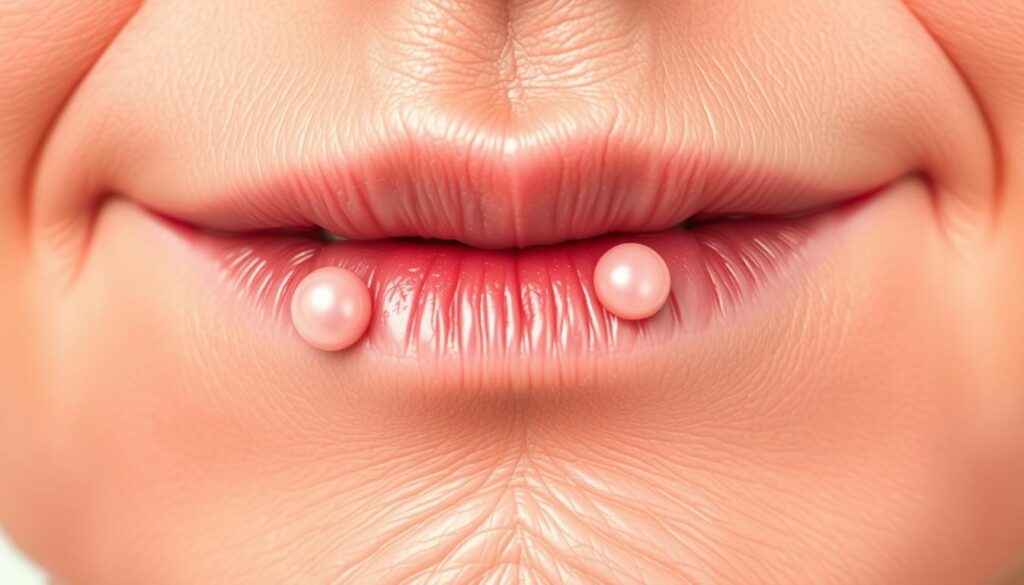Fordyce spots are small, harmless bumps on your body. They’re actually ectopic sebaceous glands that look like whitish-yellow lesions. These spots are normal and affect many people1.
These spots usually show up during puberty. They can appear in various places on the body2. Fordyce spots are more common in males.
You might find them on your lips, genitals, or other skin areas12. Don’t worry – these oral lesions aren’t a sign of any health problems3.
Fordyce spots are just a natural skin variation. They’re completely benign, though they may cause some cosmetic concerns. Research shows that 70-80% of adults have these harmless bumps12.
Key Takeaways
- Fordyce spots are normal ectopic sebaceous glands
- They affect 70-80% of adults
- More common in males
- Typically appear during puberty
- Completely harmless and not a medical condition
Understanding Fordyce Spots: Identification and Characteristics
Fordyce spots are common skin bumps that often worry people. They appear in various body areas, causing curiosity and sometimes anxiety. These mucosal spots have unique features that set them apart.
Common Locations and Appearance
These small bumps can develop in several areas, including:
- Lips and cheek lumps
- Genital regions
- Tongue bumps
- Oral papules
Fordyce spots are tiny, raised bumps that blend with your skin tone. They’re usually yellow-white and appear during or after puberty. About 85% of people have these spots.
Physical Characteristics and Size
These spots have consistent physical properties:
- Size: 1-5 mm in diameter
- Texture: Smooth and raised
- Color: Yellow-white or skin-colored
Interestingly, Fordyce spots are twice as common in men than women4. They often show up on oily skin. Men aged 17-67 are most likely to have them5.
Distinguishing from Other Skin Conditions
It’s important to tell Fordyce spots apart from other skin issues. Unlike genital warts or herpes sores, these spots are harmless. They don’t spread and don’t cause symptoms.
- Non-infectious
- Asymptomatic
- Harmless
Fordyce spots can be confused with various skin conditions, including milium cysts, epidermoid cysts, and sebaceous hyperplasia5.
Fordyce spots don’t need medical treatment. They’re a normal skin variation. While they might look worrying, they’re completely natural6.
Treatment Options and Management for Fordyce Spots
Fordyce spots are harmless, but many seek cosmetic solutions. Several treatment options can help manage their appearance. Let’s explore some effective approaches.
Laser skin resurfacing is a powerful method for addressing Fordyce spots. It targets and destroys the underlying glands. This advanced technique can significantly minimize the spots’ visibility7.
- Cryotherapy: A cold-based treatment that freezes and removes the spots
- Micro-punch surgery: A precise surgical method for spot removal
- Electrocautery: Uses electric current to target problematic glands7
Topical approaches offer alternative treatments:
- Retinol creams to potentially shrink the spots
- Over-the-counter treatments like tea tree oil
- Witch hazel for potential skin improvements7
Important: Always consult a healthcare professional before attempting any treatment to avoid potential risks of scarring or skin discoloration.
Patients 18 and older can usually receive Fordyce spot treatments. The process involves a consultation, patch test, and main treatment. Medical professionals carefully manage each stage8.
Note: Recovery may require abstaining from certain activities for about a week to ensure proper healing8.
Conclusion
Fordyce spots are harmless and common. These small, white or yellowish papules appear on lips and genital areas. They affect most people, so there’s no need to worry910.
These spots are not a medical issue. They’re just visible sebaceous glands, part of your natural anatomy. Professional medical resources confirm their benign nature.
Fordyce spots are extremely common. They affect 80-90% of the population9. Most people don’t need medical intervention for these spots.
If you’re unsure, consult a dermatologist. They can provide personalized guidance and reassurance. Remember, these spots are just another unique aspect of your body.
Embrace Fordyce spots as a natural part of your skin. They don’t indicate health issues or require treatment. Only consider cosmetic modifications if you truly desire them.
FAQ
What exactly are Fordyce spots?
Where do Fordyce spots commonly appear?
Are Fordyce spots a sexually transmitted condition?
Can Fordyce spots be treated?
How can I distinguish Fordyce spots from other skin conditions?
Do Fordyce spots cause any health problems?
Can I remove Fordyce spots at home?
Source Links
- Fordyce Spots: Identification, Treatment, and More – https://www.healthline.com/health/fordyce-spots
- What to Know About Fordyce Spots on Your Foreskin – https://www.webmd.com/skin-problems-and-treatments/what-to-know-about-fordyce-spots-on-your-foreskin
- Fordyce Spots: Why They Develop and How to Get Rid of Them – Riverchase Dermatology – https://www.riverchasedermatology.com/blog/fordyce-spots-why-they-develop-and-how-to-get-rid-of-them/
- Fordyce spots: Treatments, risk factors, and symptoms – https://www.medicalnewstoday.com/articles/256918
- Could the Bumps on Your Lips, Mouth, or Genitals Be Fordyce Spots? – https://www.health.com/fordyce-spots-8413619
- Fordyce spots (syn. Fordyce’s granules) – https://www.pcds.org.uk/clinical-guidance/fordyce-spots-syn-fordyces-granules
- How Do You Get Rid of Fordyce Spots? 6 Best Ways, Symptoms, Causes, Prevention – https://www.medicinenet.com/how_do_you_get_rid_of_fordyce_spots/article.htm
- Fordyce Spots Treatment | London & Birmingham | Clarewell Clinics – https://clarewellclinics.co.uk/genital-dermatology/fordyce-spots/treatment/
- Differentiating Fordyce Spots from Their Common Simulators Using Ultraviolet-Induced Fluorescence Dermatoscopy—Retrospective Study – https://pmc.ncbi.nlm.nih.gov/articles/PMC10000991/
- Fordyce Spots on Your Foreskin – Consensus: AI Search Engine for Research – https://consensus.app/home/blog/fordyce-spots-on-your-foreskin/
